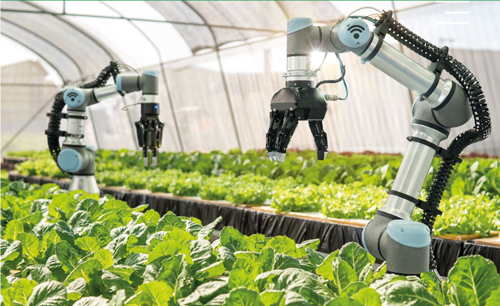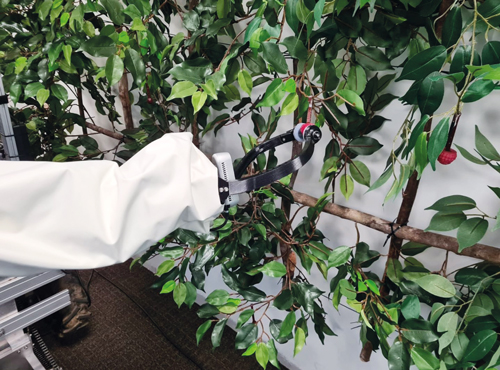The pandemic has impacted the global economy in several ways, and when it comes to technology, and imaging in particular, some areas have fared better than others. Image sensors to guide robots cleaning hospitals or thermal imaging for screening for signs of fever are examples of advanced imaging playing a key role.
But with issues such as the cost to transfer emerging technology into a commercial product, and lockdown causing disruptions to supply chains and production volume, will the pandemic have a significant effect on research and development? And will this mean further hurdles when it comes to bringing new technology to market?
Many vision industry representatives have remained optimistic. In a recent webcast, hosted by Imaging and Machine Vision Europe, Anne Wendel, director of VDMA Machine Vision, said: ‘Of course we are all [vision firms] affected, but we believe that the machine vision industry will be the first to get out of this hole.’ Jeff Burnstein, president of the North American automation association A3, said: ‘Coming out of this, we expect to see an increased adoption [of automation] in many industries.’ He did acknowledge, however, that the vision industry could suffer the impacts of this crisis for a while.
The UK’s Knowledge Transfer Network (KTN) was set up to help the innovation landscape. Matthew Wasley, knowledge transfer manager, photonics, believes that one of the biggest challenges, regardless of Covid-19, is funding. He explained: ‘We often come across a technology from a university or an R&D lab, which accelerates up to a certain point, and you can get grant funding, and then it stops because essentially what the government can fund is limited. It reaches a point where it needs private investment to take over.’
This is usually overcome, said Wasley, by companies biting the bullet and investing, or by alternative solutions such as the innovation loans pilot scheme, via the UK government innovation agency, Innovate UK. Initially launched in 2017 for a period of two years, the scheme was extended in 2019 with a further £25m made available.
Alternatively, there is the venture capital option to take things further. ‘Obviously, products do get out there,’ he said.
Back in the lab
In terms of the pandemic, Wasley has witnessed a few ways in which the industry has been impacted. ‘The experience from people I talk to is that most companies have been able to get on with it and get into their factories or labs. There have been some issues with clarity at the start, as to whether they could do that, but they have kept going. The academic institutes have found it much more difficult.’
This has led to manufacturers waiting on the academic institutions involved with their R&D, as they were unable to get into their laboratories. ‘That’s starting to get moving again,’ Wasley said, but one of the biggest hurdles thrown at the industry by Covid-19, takes us back to investment.
‘The lack of face-to-face meetings,’ he said, ‘has slowed down investor confidence, but everybody is in the same boat. In fact, there are some fields where investment has actually grown slightly.’ Quantum technology, for example, has seen investment go up, although as Wasley said, this could also be because ‘possibly investors have a higher-risk appetite.’
One way in which R&D has been aided is via the Innovate UK drive to rebuild the economy through its sustainable innovation fund. This aims to rebuild from the damage caused by Covid-19 through investment in innovation. ‘The prominent message that is coming out is about building the green economy,’ said Wasley. ‘On a practical level there has been around £200m worth of funding specifically for R&D for either tackling the effects of covid or mitigating the economic damage of it.’
The funding has also been used to help combat the issue of labour shortage due to the pandemic. This is where imaging and machine vision technology has come into its own, Wasley explained. ‘With fruit picking, for example, people can’t come across and pick fruit as usual, so we are funding robotics, but also vision technologies.’
The fruit picking work in which KTN in involved is part of a large UK agri-food consortium that was formed to address agricultural labour shortages by accelerating the use of robotics and automation for picking and packing fresh fruit and vegetables. The effort is being co-ordinated alongside the University of Lincoln, the National Farmers Union (NFU), Agri-EPI Centre, and the Manufacturing Technology Centre, with the backing of more than 100 of the UK’s fresh food producers.
Easing growing pains
The consortium has trialled several new robot-based systems on farms producing strawberries, apples, blueberries, lettuce and broccoli. Those approved technologies will then be manufactured at scale and fully implemented for the 2021 growing season.
Simon Pearson, professor of agri-food technology at the University of Lincoln, said: ‘Around 70,000 workers are needed annually to pick and pack these products. Due to Covid-19 restrictions, it is estimated that only 30 per cent of migrant agricultural workers are expected to come to the UK this season [2020], with uncertainty continuing in the future. This could cause severe problems for numerous market sectors, such as fruit and vegetable picking, which, ultimately, will reduce the availability of food for the UK at a time when it is needed most.’

KTN is involved in a UK agri-food consortium formed to address labour shortages by accelerating the use of robotics. Credit: KTN
Ali Capper, chair of the NFU Horticulture and Potatoes board, added: ‘This is an excellent initiative and one that is long overdue. British fruit and veg growers have an ongoing challenge around the availability, cost of – and access to – seasonal labour, exacerbated by Brexit and now Covid-19. This is a global challenge with many countries around the world facing seasonal labour difficulties. I commend the consortium for their energy in trying to accelerate the use of robotics in the fruit and veg sectors, and look forward to being part of the team that brings new robotic solutions forward to British farmers and growers.’
Wasley said: ‘There are some opportunities coming out of the pandemic, because industries that are usually a bit more hesitant to switch over to new kinds of technology are having to do that more urgently than they thought.’
In terms of helping these companies bring new technology to market, KTN has been doing its bit to bring people together. ‘We have just released our new strategy,’ Wasley said. ‘So we’re all about connecting for positive change, and to support the UK economy. Now we have, within that, sustainability and diversity, which is really good to see.’
More generally, said Wasley, organisations such as KTN have been providing platforms to encourage business interaction at a time where doing so has been more difficult, physically. ‘Some if not all of our webinars and events have got some opportunity for networking there,’ he explained. ‘So we use tools where people can book networking meetings alongside our webinars, and we’ve found takeup to be amazingly high.’
Let’s get together
From research conducted during a number of KTN events, Wasley pointed out the importance of being able to network for companies and academic institutions looking to bring imaging technology to the commercial market. For academia, the most important reason to attend an event is to find out the latest information from speakers and other experts, whereas for companies, it is networking and meeting people that’s important. ‘That’s really hard to replicate online,’ he admitted. ‘So we have set up bookable meetings for delegates on a more direct basis.’
Wasley is positive that the continued funding available will help with the drive to bring new imaging and vision technologies to market. ‘Innovate UK has really grasped the nettle and made funding more available for businesses, and it is carrying on with its existing funding programme,’ he said. In addition, it had the Covid-19 response call, a loans scheme, and the Smart Grant competition, which is open for any area of innovation. Included in that is accelerated funding. Innovate UK is offering funding alongside private investors. Schemes are additionally available for companies that have previously received funding, such as robotics firm, Fieldwork Robotics, part of the Frontier IP Group.
Innovate UK awarded the company an £84,000 continuity grant to accelerate development of agricultural robot technology. Fieldwork Robotics is focused on developing technology to harvest soft fruit such as raspberries, along with vegetables, to help growers to address issues surrounding labour shortages in agriculture.
The company, a spin out from the University of Plymouth, won its first grant of £547,250 under the Innovate UK Industrial Strategy Challenge Fund in April last year. This was part of a £671,484 project alongside partners including the University of Plymouth and the National Physical Laboratory.

Fieldwork Robotics has completed field trials with some of the largest soft fruit growers in the UK. Credit: Fieldwork Robotics
Since then, Fieldwork Robotics has completed field trials with some of the largest soft fruit growers in the UK, and raised £320,000 through an initial equity fund. It announced a collaboration with Robert Bosch in July to optimise the robot’s arms and software development, to reduce cost and increase speed as part of a drive towards full-scale commercial production.
The company has also progressed in developing further applications of the technology to harvest other fruit and vegetables, in addition to raspberries.
Fieldwork Robotics was incorporated to develop and commercialise the work of Martin Stoelen, who splits his time between the University of Plymouth, where he lectures in robotics and leads the Soft and Adaptive Robotics lab, and as an associate professor at the Western Norway University of Applied Sciences.
The robot works by using different cameras for different functions. It has what the company calls ‘global’ cameras, for tasks such as fruit identification, as well as ‘local’ cameras to support the final stages of harvesting.
The robot then takes advantage of artificial intelligence-visualisation techniques to sort fruit that meets the standards set by supermarkets, in terms of ripeness, size, colour and other parameters.
The place to be
The UK government has published an R&D roadmap, and a commitment to increase public investment in R&D to £22bn by 2024 to 2025. ‘The existing funding will also continue,’ explained Wasley, ‘and we will see innovation funding continuing – both challenge-led funding and open funding.
‘We may well see the government set up an agency for specific challenges and advanced projects that are more high-risk and therefore difficult to get funding. Businesses doing something towards particular challenges are in a good position; those looking at open funding are in a much more competitive environment. That’s on grant funding. I think we’ll certainly see debt funds and equity investment continuing’ said Wasley.
‘The world is turning and we’ll see a much bigger or increasing focus on sustainability.’
Imaging and machine vision will have an important role to play here, both in terms of efficiency and also new technologies that can help with the issues surrounding it.
For companies looking at R&D grants Wasley advises that keeping an eye on where the specific challenge funding is and positioning towards enabling a green recovery ‘is always a sound place to be.’
This green recovery is taking place globally, but certainly funding in this area is a focus in the UK and Europe, explained Wasley.
‘Funding and investment, be it through the European Investment Bank or the UK government and the British Investment Bank, is always going to be a focus and I think the big question for the next 12 months is whether, and how, the UK associates with the European Union.’
Wasley said that with Europe getting ready for the successor of Horizon 2020, the UK will have to consider this international collaboration, which is still seen as very important.
‘There will be opportunities across Europe and wider,’ he said. ‘It’s positive. I really think there is a light at the end of the tunnel, but it is going to require people to think differently.
‘Industry has always had to adapt to survive and grow, and I think that’s going to be more important than ever. The businesses that can pivot quickly and find new opportunities are going to be in a really good place.’


